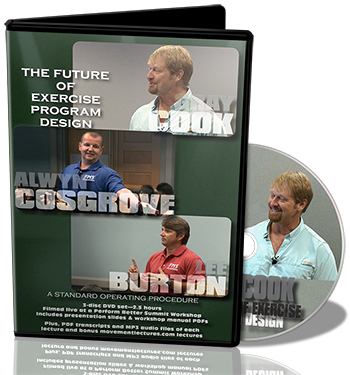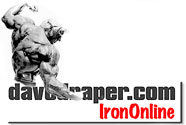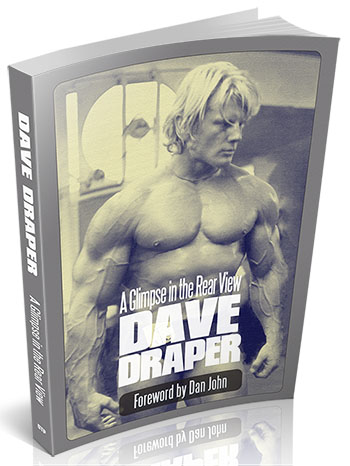Bentover Rows, Powerful Mass Builder

The Future of Exercise Program Design DVD, new October 2013
Download the full Draper here newsletter
in printable, live-link, pdf format, here.
Okay, people. Settle down. Let me have you attention, please. Put your baseball cards away; we’ve got a lot to do. Work in physics is defined by the equation [w=fs]: force put through distance and is measured in foot-pounds. Here’s your assignment: calculate the number of foot pounds you perform in your next back workout and mail in the results for group comparison.
For example, the bentover row: multiply the weight used, 100 pounds, times the distance traveled, 2 feet, times the number of reps performed, 10 reps. In this case we have work equals 100x2x10, or 2,000 foot-pounds (1 ton). Multiply this result by the number of sets performed (5) and we have 10,000 foot-pounds, or five tons. Very good. So much for physics and math.
Now moving on to our study of psychology, I want you to write in 50 words or less why anyone in their right mind would lift this much weight. Year after year. Are we strange? Do you think it’s a good idea we go on like this, unsupervised? Are we, excuse the psychobabble, all in denial?
And, incidentally, speaking of the aforementioned bentover rows, let me say they are the best of the powerful back-builders. Wide-grip chins are up there in importance for lat width, pulldowns to the front are significant for muscularity and V shape, seated lat rows are standard for full back shaping, never to be omitted.
But barbell rows are king.
Thing is, they’re the toughest, meanest and most demanding upper body movement. Bentover rows are a comprehensive exercise like squats, deadlifts and standing military presses. They work large and specific muscles (the full back), yet engage the whole system in their execution--fingers to toes. Therefore, systemic, whole body growth is accomplished, along with deep fatigue and an accentuated need for recovery.
Rows are a power exercise and are most effective when performed with heavy weight. The movement is basic, takes practice and conditioning over months to allow you to safely perform with body thrusts that recruit the muscle mass. The bent over torso acts as a lever under the resistance of the bar. The lower back, the spinal vertebrae, supported by the erectors, provide the fulcrum and bear an extraordinary load. Be careful.
We should all, young and old, toughen our lower backs with hyperextensions and lightweight deadlifts throughout our weekly training. This will also prepare us for the wear of everyday living, athletics and these heavier lifting endeavors.
To protect my lower back, I assume a relatively close standing position, bend over with my ribcage somewhat supported by my thighs, back flat, eyes focused somewhere 10 feet before me to correctly position my head. I grab the bar overgrip some six inches from the collars of an Olympic bar. I settle in, major focus on grip and body position as I deep breathe three or four times in preparation. I tightly pull the bar to the mid-chest or thereabouts, and deliberately lower to the starting position, just short of or tapping the floor. Then, it’s up again with muscle power, down again with negative focus.
A warmup of light weight, 12-15 reps to locate the groove, align muscles and attachments, raise the blood flow and area temperature is always wise and welcome. Now you’re ready to continue with a smart four sets of 8-10 reps. When you’re ready, a 12-10-8-6 rep system is always agreeable and productive.
Depending on your level of development, include rows two times per week as an exercise for reps, perhaps less if you blast it. Practice this consistently for months, not just occasionally. One-arm dumbbell rows are a great alternative to keep heavy action going, yet give the low back a rest between heavy barbell rowing sessions.
Vary your grip from wide to close to discover the change in muscle action: the closer the grip, the tighter, more central the back involvement. The wider grip means broad muscle action, more freedom, plus rear delt stuff.
There’s a big load on grip, forearm and biceps. Quads, hams and glutes get pumping as you get into heavy pulling. Sometimes stiff-arm pullovers with a bent bar fit well into the scheme as superset transitions.
You want the long sweep of the lower lat, thick rhomboids and rugged erectors? Reverse your grip on the bar about shoulder wide. Bend at the waist, fully extend the bar to the floor and slightly forward. Now, pull the bar just past the knees and tightly to the waist, arching the back with each contraction to emphasize the muscle action.
Better yet, use a bent bar for wrist comfort and superior contractions. Start light, practice the motion, locate your muscles and work up. You’ll sleep tonight and groan tomorrow.
Nurse, we’re ready for our medication now.
Originally published 1999
-----
You don’t have to sign up for Facebook to read Dave’s commentary and interactions on his Facebook page. Dave is on Facebook here:
http://www.facebook.com/bodybuilderdavedraper
Dave is on Twitter, here:
---
Take a trip over to our
Musclebuilding Q&A Blog
... where Dave allows us a peek into his email outbox.
Did you sign up for Dave's expanded email yet?
It's free, motivating and priceless!
We'll also send you a link to Dave's free
Body Revival Tips and Hints e-report with your confirmation notice.

